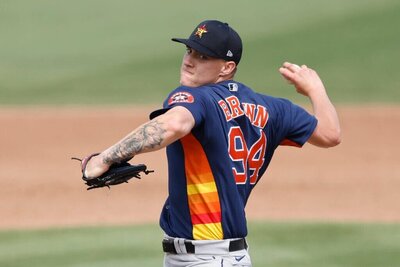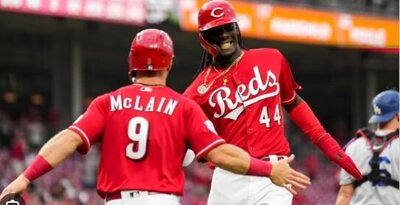Jacoby Ellsbury- Jacoby Ellsbury is pretty close to the player that fantasy owners should have expected in the pre-season. Ellsbury's plate patience, contact rates and speed generally paint the picture with perhaps a little positive regression in the second half, but by in large, he is the player we are seeing through his first 85 games. Ellsbury's BB Rate is up to 9.2% and his K Rate is up to 16.5%. These rates are within reason of his career and three-year norms so there really won't be much room for regression in his plate patience to change his fantasy value. Ellsbury is hitting a lot more line drives this season (27.7%) and a lot fewer ground balls (41.7%) than what we would consider normal for him, but even a slight regression in these numbers shouldn't overly damage his batting average. Given his .326 BABIP is in line with expected norms, it is reasonable to believe that his .280 average will not fluctuate a great deal in either direction for the remainder of the season. It is also unlikely that Ellsbury will out pace the 23 steals he obtained during the first half given his decreasing speed numbers, but he is still an effective base stealer and he should be able to manage another 20 or so over the second half. Overall, Ellsbury has not been able to reproduce his .298 batting average, 52 steal campaign from 2013, but it wasn't really very likely he would given another year of age on his wheels. As is, he is a fine fantasy value for a speed threat that won't hurt average and will score runs. He was probably over-drafted in April, but given his name value and signing a large contract with New York, that isn't all that unbelievable. He still has value to most fantasy teams, but he isn't really a No. 1 OF. More like a solid 2 or 3 on a good team.
Nick Swisher- Even in off-seasons where his batting average wasn't a solid attribute, Nick Swisher offered fantasy teams two solid aspects: he would get on base at a fairly obscene rate and he would hit for power. Sadly, his power has begun to seriously erode over the course of the last several years. Swisher has seen his ISO drop for the third straight season (.201 in 2012, .177 in 2013, .130 in 2014). The drastic decrease this season is due in large part to his lowest HR/FB Rate (8.1%) since his first full season in the big leagues. Swish just isn't driving the ball out of the yard enough to generate fantasy value. To add to this problem, Swisher has a .254 BABIP through his first 70 games. Normally, we could predict a positive regression in that number to assume that Swisher's paltry .198 batting average would rebound, but Swisher has never been very consistent in the singles percentage so trying to predict regression on that number seems like a fool's errand. Overall, the deterioration in Swisher's skill set has been drastic and leaves little room for fantasy value. In my opinion, its best to leave Swisher on the waiver wire and ignore him for the time being. Even a fairly sizeable regression in most categories still would leave you wanting for a better reserve outfielder.
Jon Singleton- A few days ago, our own Neil Parker wrote that it was time to replace Jon Singleton with a more consistent bat. I back Neil 100% in his analysis, but given Singleton's hot streak of late, I wanted to touch base on exactly what I see that agrees with Neil's thoughts. First, it is important not to overvalue a home run hitter, who finally hits a couple home runs after being on a cold streak. We all know that Singleton will take the ball for a ride, but the sacrifice you are making for those home runs is significant. His 35.1% K Rate is incredibly Chris Carter-esque. In fact, most of what I'm seeing from Singleton reminds me of Carter right now. A 30+% K Rate, a batting average below the Mendoza line, elite Fly Ball Rates (52.8% for Carter, 45.1% for Singleton) and very strong HR/FB Rates (18.8% for Singleton, 17.6% for Carter). Each is appropriately owned in about 19% of leagues. It is tough to justify carrying either player as they submarine your batting average in exchange for a couple extra home runs. Don't let the "shiny new toy" syndrome get to you. Singleton may have more upside than Carter and could develop over time, but outside of dynasty and keeper formats, he belongs on the waiver wire along with his fellow Astro.
Logan Morrison- LoMo has come back from the disabled list and played well to date. We had mentioned him as a potential waiver wire claim on the Fantistics Fantasy Radio Show on Sirius/XM Fantasy Radio this past weekend. Morrison's contact rates jump out to me as signs of positive progress from his injuries. Morrison's 39.8% Fly Ball Rate is close to his 40% rate of 2012, which was the last time that Morrison was healthy. Additionally, his 11.4% HR/FB Rate also is reminiscent of 2012. Both are solid transitions from 2013 when LoMo was hitting far too many ground balls to be of any real use to fantasy owners. His power has not flashed back to the 2011 season where Morrison managed 23 home runs, but he also hasn't had a season where he could accumulate 500+ at bats since then either. We would love to see an extended period of health for Morrison to be able to analyze a larger sample. For now, he is playing well, seems in line for solid plate appearance numbers with the Mariners and appears healthy. I'm not adding him immediately, but he is firmly on my radar as a potential solid bench addition moving forward.
Justin Verlander- Justin Verlander's decline has been well documented and frustrating for fantasy owners who paid a premium for him this draft season hoping for a comeback. The most disturbing trend for Verlander has been his 17.5% K Rate, which is his lowest since 2008. Almost all of Verlander's issues fall on the degradation of his fastball. Once, Verlander's fastball was among the elite in the game. In 2014, not only is it no longer an elite pitch, it is arguably the least valuable pitch in Verlander's arsenal. As Verlander has been unable to pitch off his fastball, he has generated fewer swinging strikes (8.9% in 2014 is the lowest of his three year sample) and allowed more free passes (8.3% in both 2013 and 2014 are six year highs). Overall, Verlander just isn't offering fantasy relevant production to this point of the season. His BABIP Against of .325 and Strand Rate of 67% paint a picture of some positive regression in his ERA, but again, if he can't use the fastball as a legitimate weapon, it will be difficult to see him regain even the fantasy relevancy of 2013, nevermind the dominance of prior seasons.
Today's American League Player Blog is brought to you by Nicholas Rossoletti. You can follow Nicholas on Twitter @NRoss56.
This is just a small sample our our daily analysis, join our member area for more premium content: http://www.fantistics.com/join/join.php3


































